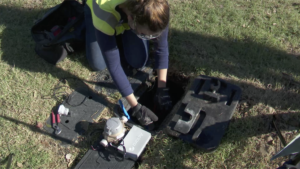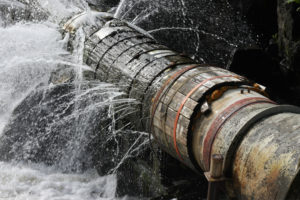
In the evolution of water distribution, advanced metering infrastructure (AMI) has become an asset in reducing labor requirements, improving customer service, and billing, and providing a baseline of information for better data management. The question is how much more can AMI do, and how can water utilities take maximum advantage? Here are some insights and ideas.
AMI — Past, present, future
From pen-and-paper record-keeping to drive-by meter reading, to fixed-network and cellular AMI, meter reading has evolved to a more efficient, accurate, and economically valuable process. While meter reading remains the overwhelming current focus of AMI technology more and more utilities are expanding their use of AMI-collected data to improve operational awareness and efficiency on the way to building more valuable smart infrastructure solutions (SIS).
An important aspect in the growing potential of AMI infrastructure is the availability of core capabilities from existing AMI applications to be utilized for benefits beyond the original meter reading and billing applications. Think of it as a logical progression of ‘mission creep’ in a positive, cost-effective light.
Installed water meters
Existing investments in collecting customer consumption data can be leveraged to support future efforts in non-revenue water (NRW) loss reduction, leak detection, and customer service functions.
Installed network infrastructure
Once an AMI network is in place, numerous additional devices and applications can be added selectively to improve distribution system efficiency.

Data management software
Data that is collected by an AMI metering solution or gleaned from supplemental instrumentation within the distribution infrastructure can be repurposed for additional uses. For example, it can be married to data from treatment plant SCADA systems or enterprise resource planning (ERP) systems to support internal maintenance decisions or broader management purposes.
Data analytics
Depending on how meter-reading data is currently analyzed, it is possible to take advantage of more analytical opportunities. Those could range from emergency event monitoring directly from billing system data, to sharing distribution infrastructure metering, sensing, and instrument data with broader analytical software.
Perhaps the greatest potential lies in growing beyond customer-focused activities (i.e., water consumption and billing) to more utility-focused activities (i.e., infrastructure, pressure, leak detection). In any case, it is about capitalizing on existing infrastructure and data/analytical systems — with or without additional investments in sensors or software.
Realistically, what’s next?
Many of the potential opportunities outlined above fall under the heading of asset management. How do I track my aging pipe, valve, and meter infrastructure? How can I monitor their operational capabilities and failures to protect scarce water resources? How can I most efficiently manage maintenance needs?
Customer care and billing
While automated data collection from residential and commercial metering is already improving billing accuracy and shortening the collections cycle, it can also help to improve the understanding of distribution operations as well as customer service. The data collected by utilities helps them provide quick notification of continuous flow caused by hidden or running leaks. It can also provide ongoing tracking of the amount of water used to help customers stay within a budget or to better conserve water for green purposes.
Distribution system leak detection and mitigation
Creating district metered areas (DMAs) corresponding to strategically positioned flow meters, proactive leak detection sensors, and shutoff valves, then monitoring them through AMI infrastructure, can create new capacity to identify trouble spots, and respond with remedial action — including automated shutoff. This can help in detecting distribution systems leaks, minimizing NRW losses, and isolating trouble spots for repairs with minimal disruption to individual service lines.

Pressure monitoring
Using AMI infrastructure to link pressure sensors strategically located throughout a distribution system can make it helpful to manage DMA zones and times when system pressure can be reduced to minimize pumping costs and water losses and reduce stress on aging pipes.
Sewer overflows
Incorporating sewer overflow monitoring into existing AMI infrastructure can reduce customer complaints, costly cleanups, and potential fines related to consent decrees or regulatory requirements.
Digital twin modeling and analytics
In addition to the everyday billing and ops/admin functions behind AMI, one of the most valuable aspects of having access to AMI digital data is the ability to support ‘digital twin’ functionality. (A digital twin is a virtual replica or digital representation of a physical object, process, service, or system that can be used to test, model, or understand the workings of the real-world application.) For many forward-thinking water utilities, the goal is to create and maintain a virtual digital twin that they can use to model, analyze, and automate and improve both current operations and future decision-making based on hydraulic modeling.
Driving a smart city strategy
When it comes to first-time AMI adoption, water utilities can control their own destiny by getting ahead of the curve to lay the groundwork for subsequent smart city implementations that are still five to 10 years in the future. Building on a communications infrastructure paid for by more accurate and complete water billing data will make incremental plug-and-play smart infrastructure solutions more cost-effective.
The Future Is Bright
Whether water utilities are already invested in AMI capabilities or just planning their first steps into automated data collection in treatment plants or distribution systems, the future is wide open.
Cloud-based analytics systems that accept data from a variety of sources facilitate an ever-increasing diversity of opportunities for energy-efficient and cost-effective performance. They can capitalize on the granular data collected from AMI systems as well as the proliferation of sensors and instruments supported by communications network technology. Water industry suppliers who facilitate both hardware and software solutions under a single integrated network will make it easier than ever for utilities to access, manage, and leverage that digital data.
Standards common to electronic hardware and networking data communications are already helping to make water technology easier to implement without bogging down water utility decision-makers in the details of underlying infrastructure. With those resources, the next wave of AMI promise is poised to take advantage of both the right infrastructure and the right mindset.
This article first appeared on the Water Online Website in May 2020